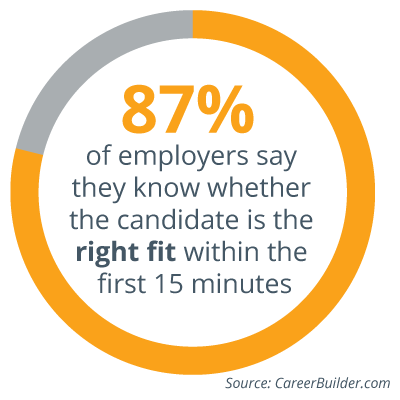Virtual interviews are now commonplace for job seekers. Many are even saying virtual interviews are the best way to interview these days, reducing the stress and cost surrounding traditional onsite interviews. But with virtual interviews so widespread, the pressure is on for companies and hiring managers to get them just right. The problem? Many human resources professionals are still unsure about how to conduct a virtual interview effectively and how to offer guidance to their companies. Unfortunately, the same often avoidable issues that plague in-person interviews often show up in virtual interviews, too.
In this blog, I’ll discuss if virtual interviews are really that different from in-person interviews. I’ll also cover why it’s so important to structure virtual interviews, plus give tips for doing it well to keep bias from creeping in.
How well do we really get to know people in interviews?
Is it really that we don’t get to know people well enough unless we see them in person? Or does meeting in person just make it easier for us to form judgments based on outside (or irrelevant) criteria?

Any time we meet a new person, we make snap judgments. We read their body language. We make assumptions based on how they look and dress. We might even make judgments based on a handshake.
All of these snap judgments happen quickly and subconsciously. But they have a deep impact on our decisions. In fact, a CareerBuilder study noted that 87% of employers say they know whether the candidate is the right fit within the first 15 minutes. Furthermore, nearly half said they could tell within the first five minutes.
It’s certainly not enough time to make a decision about a candidate based on data or their capabilities and motivations. Instead, we’re taking shortcuts and making decisions that are likely influenced by personal preferences, hunches, and biases.
Virtual Interviews Can Introduce New Biases
The scary thing is that virtual interviews just exacerbate concerns over bias-riddled hiring processes. While interviewers may have fewer opportunities to observe those in-person cues (like the hiring manager who told me that he can tell whether a person will make a good sales rep based on how they shake his hand), they now have a glimpse into candidates’ personal lives that they never had before.
During a virtual job interview, they may catch a glimpse of a person’s home interior, hear a dog barking, or see a child running in the background and reach some pretty wild conclusions. They may judge a job candidate based on a picture or poster hanging on their wall in the background.
So how do we address the slippery slope of bias that comes with virtual interviewing? The key to mitigating bias while reducing the awkwardness of the virtual interview is to add more structure to the interview process. In essence, follow many of the same best practices used by good interviewers when they interview the candidate in person.
How to Structure a Virtual Interview
In many companies, hiring managers are left to their own devices to determine how they want to structure an interview which is even riskier in a remote work environment. Without any training or structure, they typically revert to whatever they’ve experienced in their own interviews. Or worse yet, they approach the interview as they would any of the many other virtual meetings they have on a regular basis.
As a result, the interview may be unfocused, and the manager fails to collect the relevant data. After the interview, the candidate may decide they don’t even want the job. And job seekers who have had a poor candidate experience don’t keep it to themselves. Of those having a poor experience, more than 70% shared that bad experience online on an employer review site, a social networking site, or directly with a colleague or friend.
Here are seven key factors to take into account when structuring and conducting your virtual interview:

1. Determine competencies and behavioral interview questions before the interview.
Before you go fishing, it’s always good to know what you’re fishing for. Make sure your hiring managers are provided with a set of well-defined behavioral competencies that are important for success in the role. In addition, make sure you provide them with behavioral interview questions that will enable them to reliably assess candidates against those competencies. And always remember to interview every candidate for the role using the same competencies with the same set of questions.

2. Choose a reliable technology.
Virtual interviews are awkward enough, and in spite of the prevalence of virtual meetings, job seekers may have heightened concerns about using technology for this important interaction. Try to minimize the likelihood that you encounter technical difficulties by testing your technology before the interview and making sure you have a good connection. Confirm that the candidate has received instructions for accessing and using the video platform.

3. Make a positive impression.
While you may make “at a glance” judgments of the candidate, remember it’s a two-way street. Dress as professionally as you would if you were interviewing in person. Make sure your space is neat and organized. Ensure privacy during the interview and turn off potential distractions such as email and chat. Make and keep eye contact and make it clear that you are fully engaged in the interview.
The key to creating a great candidate experience is to meet the interviewee’s personal and practical needs. Build rapport with the candidate as soon as the interview begins by greeting the candidate (on time) and making them feel welcome. Remember those “life” interruptions that I mentioned earlier—put the candidate at ease by stating in advance that any of these eventualities are not a problem. Maintain or enhance their self-esteem and listen and respond with empathy by showing that you understand the candidate’s feelings and the facts of the situation.
On the practical side, set expectations for the interview. Tell the candidate that you will be taking notes, and if you plan to type let them know so they don’t think you are multitasking if they hear keyboard clicks. Make sure that you give an overview of the job and company, and manage time so that you and the candidate get what you need from the interview.

4. Appoint multiple trained interviewers.
When you only have one interviewer, the decision rests solely on their opinions and the data they gathered. But with multiple interviewers, each person provides different perspectives on the candidate, which reduces bias. In addition, an interview panel can help the candidate see a bigger picture of what the company culture is like, which is especially important in virtual interviews.
When a panel is used, each interviewer should individually review the data and rate each competency. Then, they’ll need to get together (probably virtually!) to talk about their impressions. This step is critical to making an unbiased decision.

5. Focus on behavior.
Success in most jobs isn’t just about what gets done. It’s about how it gets done. Behavioral interviewing questions focus on what candidates did and how they solved problems. While it may sound simple, the reality is that past behavior predicts future behavior and we need to make sure that hiring managers are asking the right questions to collect examples of past behavior. You might think of these questions as the ones that start with phrases like “Tell me about a time when…”

6. Use the STAR method to collect information.
The STAR method helps you to collect complete stories that show how someone acted in a situation. It’s a simple and incredibly effective way to collect accurate information and reduce bias in how you evaluate the candidate. (And you might not know it, but DDI actually invented it!)

7. Address motivational fit.
The behavioral questions and STARs can help us determine whether a candidate can do the job, but how do you know if the candidate will do the job? Motivational fit is about finding out how the candidate’s likes and dislikes relate to the job. For example, do they enjoy travel if it’s required for the role? Do they like the job's location? By assessing motivational fit, you can see whether they will be motivated and satisfied by the job and the company.
Note that motivational fit is about understanding a candidate’s likes/dislikes and determining how they align with what the job and organization has to offer. Too often, we hear hiring managers use the term “poor culture fit” to describe a gut feeling that a candidate just wouldn’t “fit in” with others at the company. But managers usually don’t have objective criteria for what cultural fit means, which can introduce bias.
Virtual Interviews Create Better Opportunities
Virtual interviews do pose a few unique challenges, but the good news is that they are easily addressed with preparation and practice, provided your organization has a sound interviewing process in the first place. While it’s true that many of us miss meeting people face to face before we hire them, video interviews present organizations with tremendous opportunities.
For example, virtual interviews enable you to source candidates from anywhere, without paying for travel. That opens up the talent pool dramatically. The bigger talent pool also means you have access to a more diverse group of candidates. And as an added bonus, it often makes it easier for candidates to make time for the interview as they don’t need to travel.
With an unprecedented amount of quality talent on the market, organizations can’t afford to get virtual interviews wrong. Those organizations that get it right and can equip their hiring managers on how to conduct a virtual interview effectively while ensuring a positive candidate experience will enjoy a hiring edge over their competitors.
As a Principal Consultant at DDI, Janice Burns is a development designer/architect who applies more than 25 years of expertise to help organizations think creatively about achieving their leadership development goals at scale. When she’s not working, Janice spends her time being trained by her Cavapoos, Toby and Strider.
Learn more by watching our on-demand webinar, Hiring During a Crisis: Interviewing for Amazing.
Topics covered in this blog

